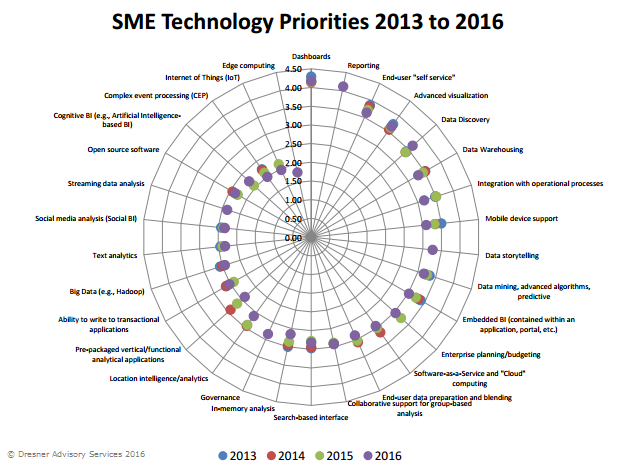More small and midsized enterprises (SMEs) today are investing in Business Intelligence (BI) tools.
According to the Small and Mid-sized Enterprise Business Intelligence Market Study, SMEs are more likely to invest in BI sooner than large businesses. They are also more likely to report success in their BI implementations.
The independent market study provides a detailed review* of BI usage and trends among SMEs.
"Generally, we find small organisations are early adopters of business intelligence and have the highest estimates of BI success," says Howard Dresner, chief research officer at Dresner Advisory Services, in a press statement.
"We also see that the current BI penetration is much higher, with more aggressive future plans at small (companies) compared to large organisations."
*in this study, small enterprise: 1 – 100 employees; mid-sized enterprise: 101 – 1,000 employees; large enterprise: > 1,000 employees
The SME Shift To Business Intelligence
For years BI was something only big players could afford. Well-funded large corporations tapped on BI to transform mountains of raw data into meaningful, actionable insights. They monitored business performance, spotted new market trends, and adapted swiftly to change.
The secret to their success? Teams of data analysts and IT professionals who stood behind complex BI tools.
For SMEs, this advantage lay beyond their reach. Yes, they recognise the importance of capturing data that streams into their businesses. But without large corporation-like funding, many settled for basic analytics in Excel instead.
Now things have changed. Affordable, user-friendly and sophisticated, today’s BI tools give SMEs benefits once held by big players.
For example, Dresner’s study showed that data discovery gained momentum among SMEs in 2016. Mainstays like dashboards, reporting and advanced visualisation continued to sustain high interest. On the other hand, basic pre-packaged applications (which one would expect to appeal to SMEs) fell most sharply across four years of study.

The study also showed that:
- Compared to their large counterparts, SMEs are more interested in Cloud and open source BI solutions
- Smaller companies are more likely to focus on BI objectives that boost revenue and competitive advantage. Large organisations favour BI initiatives that improve operational efficiency
- While operations and executive management are the largest drivers of BI at organisations of any size, Sales and Marketing take bigger roles at SMEs
- SMEs (with thinner management ranks) are most likely to want BI for executives. They also have higher interest in customer empowerment
- Current BI penetration among smaller companies is much higher. Their future BI plans are also far more aggressive compared to large companies
Why More SMES Care About BI
With the rise in self-servicing Cloud-based BI tools, more executives and employees are using BI to unearth and demystify business data on their own. This helps them make faster tactical and strategic decision-making.
“The new benefits that big data analytics brings to the table are speed and efficiency. Whereas a few years ago a business would have gathered information, run analytics and unearthed information that could be used for future decisions, today that business can identify insights for immediate decisions. The ability to work faster – and stay agile – gives organisations a competitive edge they didn’t have before,” says Dresner.
Packed with informative visualisations, BI dashboards can offer SMEs insights about the inner workings of business processes, vendor/customer relationships, and other factors that influence the bottom line. The report also showed that SMEs seek to gain (in descending order of importance):
- Better decision-making
- Improved operational efficiency
- Growth in revenues
- Increased competitive advantage
- Enhanced customer service
Microsoft Power BI: Great for SMEs, and Free to Use
One excellent BI tool for SMEs is Microsoft Power BI.
Cloud-based and highly affordable (Basic version is free, while the Pro version is just US$9.99 per user per month), Power BI empowers users with a single view of their most critical business data. Not only can SME users monitor their business health with a live dashboard and create rich interactive reports, they can also access important data on the go.
See the comparison between the free and Pro version here.
Some of Microsoft Power BI’s benefits include:
- Quick holistic view of business key metrics from any data source
- Whether it’s Excel, cloud services, or databases from ERP software like Microsoft Dynamics NAV or SAP Business One
- Get real-time updates and information
- Immediately know and solve problems and seize opportunities as they occur with real-time Power BI dashboards
- Get answers the way it’s asked
- Power BI’s natural language processing means typing questions like "What were last year's sales by region?" gets the right visualisation charts and graphs delivered every time
- Quick, easy collaboration for smarter decisions
- Collaborate with key stakeholders to ensure everyone’s on the same page
- Make accurate data-driven decisions anytime, anywhere
- Access data anywhere and anytime with native apps for Android, iOS, and Windows
To learn more about how Power BI can enhance business performance with ERP software like Microsoft Dynamics NAV or SAP Business One, please drop us a note here. We’ll be in touch as soon as possible.
Alternatively, check out The Ultimate SME Guide to ERP Systems below for a deep dive into the basic questions on ERP software for SMEs -- it's free!




